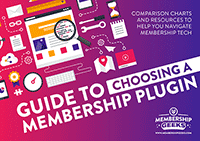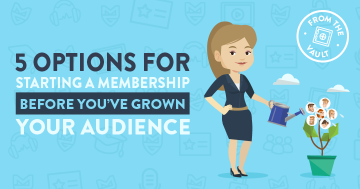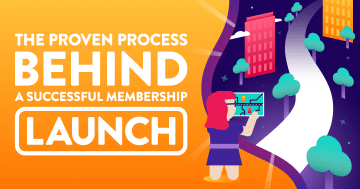How much content is enough to launch your membership site with?
There really is no set rule or one-size fits all answers. It all depends on your audience and product.
You could even launch your membership with no content at all and release content in real time.
In fact if you’re looking to get your membership up and running in record time, check out our episode on launching your membership in record time.
We get asked about what ‘enough’ content is a lot, so we’ve put together our top tips for creating content to launch your membership.
1.Stop Thinking of It as Content.
As membership site owners, you’re not selling courses, tools, or widgets.
You’re selling solutions to problems.
This is absolutely key to figuring out how much you need in your membership before you start.
When you think of it this way, you can break down your content needs by your audience’s problems.
How can you provide a solution in as few steps as possible?
The quantity of content is irrelevant if the content doesn’t solve the problems your members have.
Focus on delivering results, providing solutions, and getting people where they need to go.
You don’t need to solve every problem, just the most important ones.
When it comes to launching, identify the core problems your audience has and have something in place that acts as a solution.
2. Identify Member Avatars
If you haven’t analyzed your audience for the main archetype of members you’re going to attract based on where they are in their journey and their understanding of your topic, this is a great thing to do before you create content and marketing plans.
- What situation is your audience in when they join your membership?
- Where do they want to get to?
- What are the steps they might take?
- What are their milestones between where they want to be and where they are?
Map out the entire journey your audience might take.
If you know that your audience breaks down into three core groups, you can look at the typical journey of those three groups.
For example, if you break your audience into beginner, intermediate, and advanced, ask yourself:
- How does a beginner get to intermediate?
- What does intermediate mean?
These member avatars are particularly important if your audience can be divided into different experience levels.
If you can zero in on three to four core groups for your audience, then your starting content should be centered on providing one important thing to get each of your groups to take the next step.
3. Keep to Core Problems
When we were creating our own membership, we never asked ourselves how many courses we needed or how much content would be enough.
It was about addressing the main, compelling problem of each of our customer avatars.
We didn’t skimp.
We didn’t check boxes.
We zeroed in on what was most important to those people in those groups and made sure we smashed it.
We didn’t solve every problem every person had, but we addressed the main problem of our three different demographics to get the broadest coverage possible.
For everything else, we had the community there to answer any other questions.
4. Manage Expectations
It’s really important to manage expectations, both your own and your member’s.
We all like to think that our members will dedicate their lives to what we put out and that we need to break our backs putting out content 24/7 to keep up with their desires.

That’s never going to happen.
Your members aren’t as demanding as you expect.
Even if they were, they don’t set the rules.
You don’t have to kill yourself creating content to satisfy them.
You don’t want to create more content than your members can consume.
You’ll overwhelm them and they’ll leave because they’ll feel like they’re getting left behind.
There’s no pressure on you to have this huge behemoth of membership content from day one.
Don’t try to solve every problem with an overload of content. Focus on creating high quality solutions for core problems.
5. Remember – Your Membership is Never Finished
In membership models, there isn’t as much demand for a finished product as there is for a course.
In a course, people expect that the material is complete. It won’t evolve or grow.
For a membership, people know that they’re joining something that’s going to be added to, so you don’t have to have everything ready at day one.
You don’t stop creating content when you launch.
In fact, you might not even start until after you launch.
It’s a good idea to hold back on something because you can get invaluable feedback from your early members about what content they really want.
While people will join for the content you provide, more often than not, the reason they stick around is because of the community.
Don’t get bogged down in that the content is the end all be all.
How much content do you need to launch is the wrong question.
Instead you need to be asking yourself: what core problems do my audience members have and how do I create a solution? How do I get them to the next step?
The answer doesn’t always lie in creating content.





